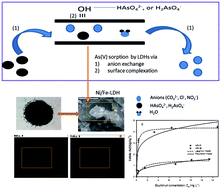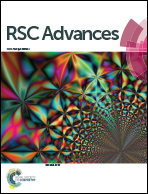Sorption of arsenic onto Ni/Fe layered double hydroxide (LDH)-biochar composites†
Abstract
Biochar is a carbon-enriched material that has been investigated for use as a remediation agent for environmental contaminants. However, in order for biochar to see practical use for metal removal, it has to be modified to improve its sorption efficiency. Layered double hydroxides (LDHs) are robust sorbents for removal of a wide array of contaminants. Thus, two LDH-biochar composites were produced by (1) pyrolysis of Ni/Fe-LDH-modified pine feedstock (NFMF), and (2) precipitation of LDHs onto pristine biochars (NFMB). Both composites were characterized and tested for their ability to remove arsenate [As(V)] from aqueous solution. X-ray diffraction, X-ray photoelectron spectroscopy, scanning electron microscopy, and energy-dispersive X-ray analyses suggested that Ni/Fe-LDH had a layered structure that was anchored on the carbonaceous surface in both NFMF and NFMB. The maximum As(V) sorption capacity of NFMF and NFMB (1.56 g kg−1 and 4.38 g kg−1, respectively) was greatly enhanced over that of the unmodified one. The results, such as increased sorption at lower solution pH, indicated that electrostatic attraction and surface complexation with hydroxyl (–OH) groups were the main As(V) sorption mechanisms for both sorbents. The good stability and As(V) sorption make Ni/Fe-LDH modified biochars high-potential sorbents for environmental remediation.


 Please wait while we load your content...
Please wait while we load your content...